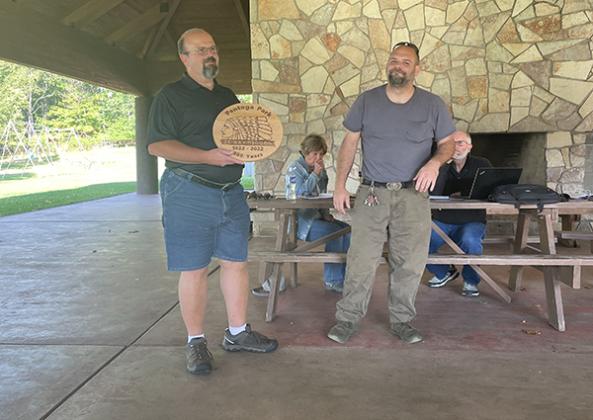Courthouse custodian Robby Olson presents Mark Stauber, chair of the Iron County Board of Commissioners, with a hand-carved wooden plaque in honor of Pentoga Park’s 100th anniversary.
By Allison Joy
CRYSTAL FALLS — In honor of Pentoga Park’s 100th anniversary, the Iron County Board of Commissioners held its September general meeting at the park’s pavillion.
Alina Shively, Tribal historic preservation officer for the Lac Vieux Desert Band of Lake Superior Chippewa Indians spoke before the board and meeting attendees about Tribal connections to the land, before it became the park known today.
“Many historical accounts of the Chicagoan Lake village reference this sacred place as ‘abandoned,’” she said. “... From my understanding, many of these ancestors buried on this land, my ancestors, lost their lives to disease of which we had no immunity nor defense against. The survivors of the disease moved back to the greater Lac Vieux Desert Community on Lac Vieux Desert Lake, near the Michigan-Wisconsin border.”
She looked out across the water briefly, before continuing: “I tend to imagine what life would be like on this land, had this disease not devastated the happy, thriving, joyful community who lived in this beautiful place. I look at the view and I know this is a special place. We never chose our homes by mistake.”
In his book “Be-Wa-Bic Country: The Story of the Menominee Iron Range in the Upper Peninsula of Michigan,” author Herbert Larson, Sr. describes the burial grounds on the land that would eventually become Pentoga Park as he saw it in 1918, just before the county acquired it: “A number of the old small wooden houses which the Indians had erected were still standing but, as a whole, nature had reclaimed the area.”
Larson writes that the land had been plotted out for summer homes, something he lamented as seeming “sacrilegious.” Instead, he proposed the county purchase the land for a park and restore the grounds to create a local attraction.
“The area...should be unquestionably saved by making the area into a public park,” he wrote. “Then, with the restoration of the old Indian cemetery, we would not only have a valuable asset, but a tremendous tourist drawing card.”
As Larson tells it, a man by the name of O.M. Brown “who had been among the Indians in his early days” oversaw rebuilding the structures designating individual graves on the Native American burial grounds.
Jail workers were used for their labor, with “strict orders to pick up and save anything they found,” including axes, traps, kettles and other items.
“After the small houses were rebuilt, many of these old mementoes were placed back on the graves, but which were quickly taken by the public,” Larson wrote.
Larson goes on to refer to the grounds having been “dormant” and “forgotten,” before inviting Tribe members to return to the land to view the work. He recounts a Native American mother finding the grave of her first-born child. In fact, most of his recounting details Tribe members searching for the graves of children.
“I can assure you that the ancestors whose bodies have been placed back into the earth here have not been abandoned,” Shively said before the county board last month. “They were never deserted nor cast off …The people buried here are loved and cared for. Their spirits are acknowledged and valued. Their lives mattered. They are family to Anishinaabe people who still live and breathe today.”
On Sept. 23, 1922, 5,000 people gathering at the burial grounds for dedication ceremonies. Larson writes that it was a warm day and that Chief Anniwabi, then 90-years-old, spoke to the crowd. An interpreter translated his words of “heartfelt thanks for this token to our dead and gone brothers, sisters, fathers, mothers and relatives.”
While much of the public comment discussion about the park centered around complaints about parking, boat etiquette, seasonal rates and other recreational logistics, Shively made clear the greater meaning of the earth on which the crowd had gathered.
“This is a sacred place to the LacVieux Desert Tribe,” she said. “We will always do what is in our power to protect our ancestors who rest here. We hope that visitors will remember that these spirits are spirits who are still very much alive, and that our ancestors deserve the same respect as all others.” (Shively’s full speech is available on the Iron County Reporter Facebook page.)
Robby Olson, the courthouse custodian, presented Board Chair Mark Stauber with a carved wooden plaque in honor of the park’s anniversary.
The board also addressed the following matters at its Sept. 19 general meeting:
• The board unanimously approved its 2022 Hazard Mitigation Plan Update.
• Two appointments had to be tabled due to a lack of applicants: positions on the Human Services board and the Authority on Aging. Zach Hautala of the Iron County Economic Chamber Alliance will serve on the board for the Western U.P. Planning and Development Region, replacing former ICECA manager Mark Bromley.
• The county approved a job posting for a construction code inspector. This will be a full-time position.
The Iron County Board of Commissioners meets the second Tuesday of each month at 4 p.m. at the courthouse in Crystal Falls. More information is available at ironmi.org.


